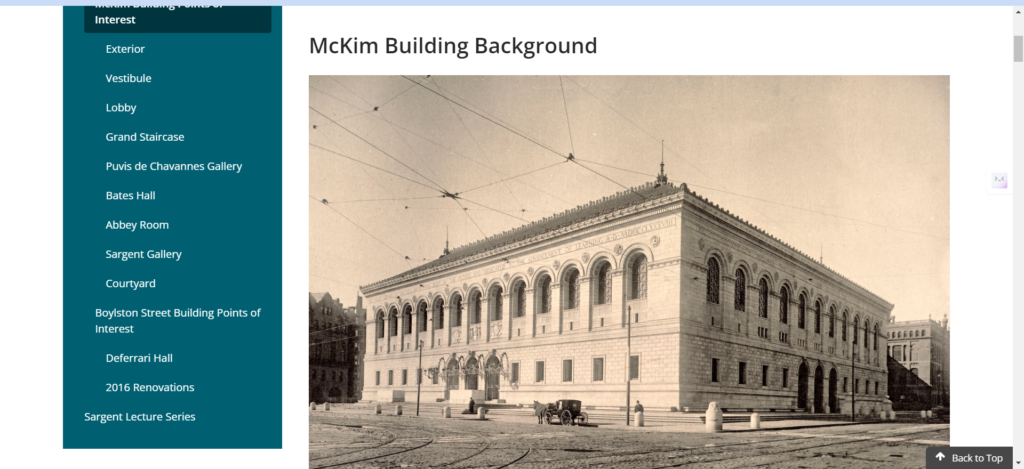Boston Central Public Library
The Boston Central Public Library stands as a cornerstone of Boston’s cultural and intellectual life, embodying a rich history that dates back to its establishment in 1848. As the first municipal library in the United States, it has become an essential part of the city’s educational and cultural framework. The library is composed of two significant buildings: the historic McKim Building and the modern Johnson Building, both of which play a crucial role in serving the diverse needs of the community.

The McKim Building, completed in 1895, is renowned for its architectural grandeur and artistic significance. Designed by Charles Follen McKim of the renowned architectural firm McKim, Mead & White, it features stunning murals by John Singer Sargent and Pierre Puvis de Chavannes, along with intricate marble work and a grand staircase that have made it a landmark of cultural heritage. This building is not only a repository of knowledge but also a monument to the artistic and architectural achievements of its era.
On the other hand, the Johnson Building, which opened in 1972, reflects the evolving needs of a modern library system. Designed by Philip Johnson, it introduces a contemporary aesthetic while providing expansive, accessible spaces for patrons. This building symbolizes the library’s commitment to adapting to the changing landscape of information access and community engagement.
The Boston Central Public Library’s dual structures embody the confluence of historical preservation and modern innovation. Together, they provide a dynamic environment for learning, exploration, and community interaction. This duality not only highlights the library’s past achievements but also its forward-looking vision of inclusivity and accessibility, ensuring that it remains a vibrant hub for generations to come.
Architectural Marvel: The McKim Building

The Central Public Library’s McKim Building stands as a testament to architectural grandeur and cultural enrichment, completed in 1895 under the visionary guidance of architect Charles Follen McKim. This edifice is a prime example of European Renaissance style, invoking the elegance and symmetry characteristic of that period. The McKim Building’s design is rooted in the Beaux-Arts tradition, emphasizing classical principles through its harmonious proportions, elaborate ornamentation, and an overarching sense of order and balance.
Often dubbed a ‘palace for the people,’ the McKim Building was conceived with the intent of democratizing access to knowledge and culture. Its exterior is adorned with intricate bas-reliefs and sculptures, enhancing the visual narrative of intellectual pursuit. The grand marble staircases within, soaring ceilings, and expansive reading rooms are all designed to inspire awe and reverence, making it more than just a library, but a sanctum of learning and reflection.
The building’s façade is a masterclass in Renaissance aesthetics, featuring arched windows that flood the interior with natural light, and a roofline punctuated by decorative cornices. Each element of the McKim Building is meticulously crafted to embody the ideals of beauty and utility, a hallmark of the Beaux-Arts movement. The interior is equally opulent, with the Bates Hall serving as the architectural crown jewel. This vast reading room, with its barrel-vaulted ceiling and oak bookshelves, offers a serene environment for scholarly endeavors.
The McKim Building’s enduring significance lies not only in its architectural brilliance but also in its role as a cultural institution. It stands as a physical manifestation of Boston’s commitment to public education and the arts, offering a space where people from all walks of life can come together to explore, learn, and grow. Through its thoughtful design and community-centered mission, the McKim Building continues to be a cherished landmark, embodying the spirit of accessibility and enlightenment.
Iconic Features of the McKim Building
The McKim Building, a cornerstone of the Boston Central Public Library, is renowned for its architectural grandeur and historical significance. One of its most striking features is the series of massive bronze doors that grace the entrance. Designed by Daniel Chester French, these doors are not merely functional but are celebrated for their intricate craftsmanship. Each door is adorned with detailed bas-reliefs that depict various themes of knowledge and learning, setting a tone of reverence as visitors step into the library.
Upon entering, one is immediately captivated by the central courtyard, an oasis of tranquility amidst the bustling city. Inspired by the Italian Renaissance, the courtyard features a beautiful fountain at its center, surrounded by verdant greenery and classical statues. This open-air space serves as both a place of reflection and a venue for various cultural events, making it a cherished part of the library experience.
Another iconic feature of the McKim Building is Bates Hall, often referred to as the heart of the library. This grand reading room, with its magnificent coffered ceiling and arched windows, exudes an aura of scholarly elegance. Named after Joshua Bates, a significant benefactor of the library, Bates Hall is a testament to the enduring importance of public learning spaces. The long oak tables and green-shaded lamps provide an inviting atmosphere for readers and researchers alike, fostering a sense of community and intellectual pursuit.
These standout features—the bronze doors, the central courtyard, and Bates Hall—collectively contribute to the McKim Building’s reputation as an architectural jewel. Each element not only enhances the aesthetic appeal of the library but also underscores its role as a bastion of knowledge and culture in Boston. The McKim Building remains a symbol of the city’s dedication to preserving its rich historical heritage while continuing to serve the educational needs of its community.
Bates Hall: The Heart of the Library
Bates Hall stands as the centerpiece of the Boston Central Public Library, epitomizing the grandeur and historic significance of this cultural institution. Upon entering Bates Hall, visitors are immediately struck by its awe-inspiring architecture. The hall’s barrel-vaulted ceilings, which stretch magnificently across the room, are a testament to the Beaux-Arts architectural style that characterizes the building. These ceilings not only enhance the room’s acoustics but also create a sense of expansiveness and grandeur.
The walls of Bates Hall are lined with shelves crafted from rich English oak, adding a touch of old-world charm and elegance. These shelves house an extensive collection of books, inviting visitors to immerse themselves in learning and exploration. Complementing the oak shelves are the hall’s beautiful arched windows, which allow natural light to flood the room. These windows not only illuminate the space but also offer stunning views of the cityscape, connecting the library’s interior with the world outside.
One of the most iconic features of Bates Hall is its distinctive green lamps. These lamps, strategically placed on the long, communal tables, provide a warm and inviting glow that enhances the reading and studying experience. The green lamps have become synonymous with Bates Hall, symbolizing the quiet dedication to knowledge and scholarship that the hall represents. The ambiance created by the combination of the vaulted ceilings, oak shelves, arched windows, and green lamps is unparalleled, making Bates Hall a cherished space for both locals and visitors alike.
In addition to its architectural beauty, Bates Hall serves as a vibrant hub for intellectual activity. Scholars, students, and casual readers alike gather here, drawn by the serene and inspiring environment. The hall’s design fosters a sense of community and shared purpose, encouraging the exchange of ideas and fostering a love for reading and learning. Bates Hall is truly the heart of the Boston Central Public Library, embodying the institution’s mission to provide a space for education, inspiration, and connection.
Artistic and Cultural Treasures
The Central Public Library in Boston is not merely a repository of books; it is a veritable treasure trove of artistic and cultural artifacts that span centuries. Among its most prized possessions are the rare first edition Shakespeare folios, which offer an invaluable glimpse into the literary heritage of the English-speaking world. These folios are often the subject of scholarly research and are displayed with great care, allowing visitors to marvel at their historical significance.
Equally mesmerizing are the original musical scores by Wolfgang Amadeus Mozart, preserved meticulously within the library’s archives. These manuscripts are more than just sheets of music; they are windows into the creative genius of one of history’s most celebrated composers. The opportunity to view these original scores is a rare privilege and a testament to the library’s commitment to preserving the cultural legacies of great artists.
The library’s collection extends beyond the written word and musical notation. It houses an impressive array of maps and prints that chart the evolution of cartography and graphic arts. These items offer a visual journey through time, showcasing the artistry and precision of mapmakers and printmakers from various eras. Whether you are a history buff or an art enthusiast, these collections provide a rich tapestry of knowledge and beauty.
Moreover, the Central Public Library is adorned with murals and gallery spaces that elevate the aesthetic experience of its visitors. The murals, created by renowned artists, depict scenes of historical and cultural significance, adding a layer of visual storytelling to the library’s environment. The gallery spaces regularly feature exhibitions that highlight various aspects of art, history, and culture, making each visit a unique and enriching experience.
In essence, the Central Public Library in Boston stands as a beacon of artistic and cultural wealth, offering an unparalleled experience for those who seek to explore the depths of human creativity and knowledge.
The 1972 Expansion: Philip Johnson’s Contribution
In 1972, the Boston Central Public Library underwent a significant transformation with the addition designed by renowned architect Philip Johnson. This expansion marked a pivotal moment in the library’s history, as it sought to address the growing needs of its collection and the increasing number of visitors. Johnson’s architectural prowess was evident in his ability to seamlessly blend modern design elements with the historic McKim Building, creating a cohesive and functional space.
Johnson’s design philosophy emphasized simplicity and functionality, which he applied meticulously to the library’s expansion. The new addition featured clean lines, open spaces, and an abundance of natural light, which contrasted yet complemented the intricate and ornate details of the original McKim structure. By doing so, Johnson preserved the historical essence of the library while introducing a contemporary aesthetic that catered to the evolving demands of the community.
The expansion included several new features that significantly enhanced the library’s capabilities. Additional reading rooms, study areas, and specialized sections for different genres were introduced, providing patrons with more versatile and comfortable spaces. Furthermore, the integration of modern technology and facilities ensured that the library could offer up-to-date services, making it a hub of knowledge and learning in the heart of Boston.
One of the standout features of Johnson’s addition was the expansive atrium, which served as a central gathering point within the library. This space not only facilitated better circulation and accessibility but also became a focal point for cultural and social events. The atrium’s design encouraged interaction and engagement, reflecting the library’s role as a community-centric institution.
Philip Johnson’s contribution to the Boston Central Public Library was more than just an architectural endeavor; it was a visionary approach that balanced respect for historical legacy with the need for modernization. His work ensured that the library remained a vital and dynamic part of the city’s cultural landscape, capable of meeting the diverse needs of its patrons for generations to come.
The Library as a National Historic Landmark
Recognized as a National Historic Landmark in 1986, the Boston Central Public Library stands as a testament to both architectural grandeur and cultural heritage. This designation, one of the highest honors bestowed upon a building or site in the United States, underscores the library’s profound influence on American society. The criteria for such recognition are stringent, requiring that a site possess exceptional value in commemorating or illustrating the history of the United States. The Boston Central Public Library meets these criteria through its distinguished architectural style, historical significance, and enduring cultural contributions.
Designed by the renowned architectural firm McKim, Mead & White, the library’s main building is a masterpiece of the Beaux-Arts style, characterized by its symmetrical design, grandiose spaces, and classical details. Opened in 1895, it was the first large free municipal library in the United States, serving as a pioneering model for other public libraries across the nation. The historic significance of the building is further highlighted by its collection of art and literature, which includes rare manuscripts, first editions, and a vast array of other important works.
Culturally, the Boston Central Public Library has been a pillar of education and community engagement for over a century. It has hosted countless lectures, exhibitions, and public events, fostering a vibrant intellectual and cultural environment. The library’s commitment to accessibility and public service has made it an indispensable resource for the citizens of Boston and beyond. Its role in promoting literacy, lifelong learning, and cultural enrichment continues to resonate, reflecting the enduring relevance of its mission in today’s rapidly evolving society.
The designation as a National Historic Landmark not only honors the library’s past achievements but also ensures its preservation for future generations. It affirms the library’s place in the nation’s collective memory, celebrating its architectural beauty and its pivotal role in the cultural and intellectual life of the United States.
Visiting the Boston Central Public Library
The Boston Central Public Library, an iconic landmark situated at Copley Square, is a must-visit destination for both residents and tourists. Accessing the library is convenient, with multiple public transport options available. The library is easily reachable via the Boston T subway system, with the Copley Station on the Green Line being the nearest stop. Additionally, several bus lines service the area, providing visitors with flexible travel choices.
Operating hours for the Boston Central Public Library are designed to accommodate a wide range of schedules. Typically, the library welcomes guests Monday through Thursday from 10 AM to 8 PM, and Friday and Saturday from 10 AM to 5 PM. On Sundays, the library opens its doors from 1 PM to 5 PM, though these hours may vary seasonally or during special events. It is advisable to check the library’s official website for the most current information before planning a visit.
Visitors can enhance their experience by participating in one of the library’s guided tours. These tours, often led by knowledgeable volunteers, offer insightful narratives about the library’s history, its architectural splendor, and notable collections. Group tours can be arranged with prior notice, and self-guided tour brochures are also available for those who prefer exploring at their own pace.
Throughout the year, the Boston Central Public Library hosts a variety of special events and exhibitions. These range from author readings and book signings to art exhibits and educational workshops. Attendees are encouraged to check the library’s event calendar to stay updated on upcoming activities that might coincide with their visit.
To make the most of your trip, consider spending time in the library’s magnificent reading rooms, such as the Bates Hall, renowned for its vaulted ceiling and serene ambiance. Additionally, the library’s courtyard offers a tranquil escape within the bustling city, perfect for reflection and relaxation.
Whether you are an avid reader, a history enthusiast, or an architecture admirer, the Boston Central Public Library promises a rich, immersive experience. By planning ahead and taking advantage of the available resources, visitors can fully appreciate the library’s cultural and historical significance.













